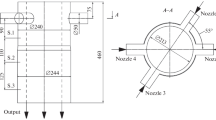Abstract—
The KORSAR/CFD code results from the development of the KORSAR/GP system code certified in 2009 by the Rostekhnadzor (Federal Service for Ecological, Technological, and Nuclear Supervision) as applied to the calculated justification of the safety for VVER reactors. One of the important aspects of development consists in the introduction of the CFD-module code into functional content for the simulation of spatial turbulent flows in the mixing chambers of reactors using a nested boundary method in the RANS-approximation. The CFD module is combined with a one-dimensional model according to a semi-implicit scheme as a standard code element. Calculation results using the KORSAR/CFD code are presented for the following three modes with the asymmetrical operation of a VVER-1000 reactor’s flow-circuit loops. They consist in breaking the steam pipeline in the steam generator, in connecting the main circulation pump while initially operating three pumps at the reactor power of 71% with respect to the nominal one, and in connecting a pump while initially operating two opposite pumps at the reactor power of 52% with respect to the nominal one. The calculations have been carried out based on the input data file for the NPP power unit with a VVER-1000 developed by the specialists in VVER design at OKB Gidropress, the Chief Designer in the field of VVER reactor units. A three-dimensional simulation of coupled neutron-physical and thermohydraulic processes in the reactor core has been performed. A thermohydraulic model of the reactor core has been used in a channel-by-channel approximation and a program block for the calculation of three-dimensional neutron kinetics. In the problems under consideration, the three-dimensional simulation domain for the CFD module includes four inlet manifolds and a part of the reactor pressure chamber before entering the holes in the elliptical bottom of the shaft. The holes in the elliptical bottom and the area beyond the shaft up to the outlet manifolds have been represented by the elements of a one-dimensional model. Based on the results of the calculations, the heat-carrier flow pattern in the reactor pressure chamber has been analyzed. A flow pattern effect exerted on the dynamics of the liquid temperature distribution at the entry into the fuel assemblies of the core and on the energy release power of the fuel assemblies in the simulated modes has been demonstrated.











Similar content being viewed by others
REFERENCES
Software Complex KORSAR/GP. Software Certification Passport No. 263 of September 23, 2009 (Federal’naya Sluzhba po Ekologicheskomu, Tekhnologicheskomu i Atomnomu Nadzoru, 2009).
Yu. V. Yudov, “A two-fluid model of unsteady circuit thermohydraulics and its numerical realization in the KORSAR computer code,” Therm. Eng. 49, 895–900 (2002).
D. Bertolotto, A. Manera, S. Frey, H.-M. Prasser, and R. Chawla, “Single-phase mixing studies by means of a directly coupled CFD/system-code tool,” Ann. Nucl. Energy 36, 310–316 (2009). https://doi.org/10.1016/j.anucene.2008.11.027
D. L. Aumiller, E. T. Tomlinson, and R. C. Bauer, “A coupled RELAP5-3D/CFD methodology with a proof-of-principle calculation,” Nucl. Eng. Des. 205, 83–90 (2001).
R. Baviere, N. Tauveron, F. Perdu, and E. Garre, “System-CFD coupled simulation of the Phenix reactor natural circulation test,” in Proc. 15th Int. Topical Meeting on Nuclear Reactor Thermal-Hydraulics (NURETH-15), Pisa, Italy, May 12–17, 2013 (American Nuclear Soc., 2013).
M. Jeltsov, K. Koop, P. Kudinov, and W. Villanueva, “Development of a domain overlapping coupling methodology for STH/CFD analysis of heavy liquid metal thermal-hydraulics,” in Proc. 15th Int. Topical Meeting on Nuclear Reactor Thermal-Hydraulics (NURETH-15), Pisa, Italy, May 12–17, 2013 (American Nuclear Soc., 2013).
A. Papukchiev, G. Lerchl, C. Waata, and T. Franck, “Extension of the simulation capabilities of the 1D system code ATHLET by coupling with the 3D CFD software package ANSYS CFX,” in Proc. 13th Int. Topical Meeting on Nuclear Reactor Thermal-Hydraulics (NURETH-13), Kanazawa, Japan, Sept. 27 – Oct. 2, 2009 (American Nuclear Soc., 2011).
Yu. V. Yudov, S. S. Chepilko, and I. G. Danilov, “Numerical implementation of a three-dimensional thermal hydraulics model based on the nested boundary method in the KORSAR/CFD computation code,” Vopr. At. Nauki Tekh. Ser. Mat. Model. Fiz. Protsessov, No. 4, 46–56 (2018).
Yu. V. Yudov, I. G. Danilov, S. S. Chepilko, and D. S. Kasterin, “Combining one-dimensional and three-dimensional thermal hydraulics models in the KORSAR / CFD computation code,” Vopr. At. Nauki Tekh. Ser. Mat. Model. Fiz. Protsessov, No. 1, 57–68 (2019).
Yu. V. Yudov, S. N. Rumyantsev, S. S. Chepilko, and D. S. Kasterin, “Verification of the KORSAR/CFD computer code against experimental data on boron mixing in the VVER-1000 model,” in Proc. 10th Int. Sci.-Tech. Conf. Safety Assurance of Nuclear Power Plants with VVER (MNTK-10), Podol’sk, Rossiya, May 16–19, 2017 (Gidropress, Podolsk, 2017).
Software Tool SAPFIR_95&RC_VVER.2. Software Certification Passport No. 321 of April 18, 2013 (Federal’naya Sluzhba po Ekologicheskomu, Tekhnologicheskomu i Atomnomu Nadzoru, 2013).
Software Tool SAPFIR_95.1. Software Certification Passport No. 390 of December 16, 2015 (Federal’naya Sluzhba po Ekologicheskomu, Tekhnologicheskomu i Atomnomu Nadzoru, 2015).
S. Kim and B.-J. Chung, “A scale analysis of the turbulent mixing rate for various Prandtl number flow fields in rod bundles,” in Proc. 9th Int. Topical Meeting on Nuclear Reactor Thermal-Hydraulics (NURETH-9), San Francisco, CA, Oct. 3–8, 1999 (American Nuclear Soc., La Grange Park, IL, 1999).
A. Bucalossi, F. Moretti, D. Melideo, D. Gallori, et al., “Experimental investigation of in-vessel mixing phenomena in a VVER-1000 scaled test facility during unsteady asymmetric transients,” Nucl. Eng. Des. 241, 3068–3075 (2011). https://doi.org/10.1016/j.nucengdes.2011.05.005
Author information
Authors and Affiliations
Corresponding author
Additional information
Translated by O. Polyakov
Rights and permissions
About this article
Cite this article
Yudov, Y.V., Petkevich, I.G., Artemov, V.G. et al. Three-Dimensional Simulation of a VVER-1000 Reactor’s Pressure Chamber in the Modes with Asymmetrical Loop Operation Using a KORSAR/CFD Computation Code. Therm. Eng. 66, 847–857 (2019). https://doi.org/10.1134/S0040601519110107
Received:
Revised:
Accepted:
Published:
Issue Date:
DOI: https://doi.org/10.1134/S0040601519110107




